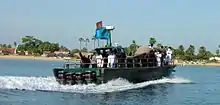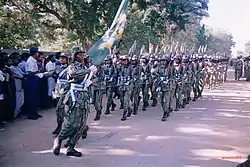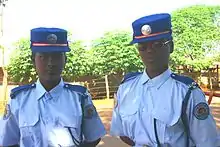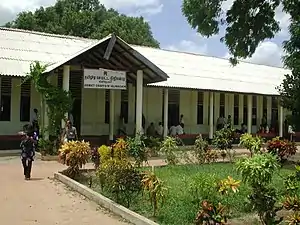Divisions of the Liberation Tigers of Tamil Eelam
Divisions of the Liberation Tigers of Tamil Eelam refers to the military, intelligence and overseas divisions the Liberation Tigers of Tamil Eelam (LTTE). Most of these divisions were destroyed during the Eelam War IV, and only parts of the intelligence and financing divisions remain overseas.[1]
Military wing

Charles Anthony brigade
Charles Anthony Brigade was the first conventional fighting formation created by the LTTE, on 10 April 1991.[2] It has remained the main fighting force throughout the rest of the time of LTTE, and has fought major battles including Operation Jayasikurui, Battle of Mullaitivu, Battle of Kilinochchi, Second Battle of Elephant Pass and LTTE's Unceasing Waves (Oyatha Alaigal) I, II, III and IV.[3] The brigade was named after Charles Lucas Anthony alias Seelan, who had been LTTE leader Velupillai Prabhakaran's right-hand man during the early stages of LTTE. Kandiah Balasegaran alias Balraj, Amuthab and Gobith have served as its commanders. Charles Anthony brigade had been completely destroyed during the final days of Sri Lankan Civil War.
Black Tigers
Black Tigers is the LTTE division that carried out suicide attacks in the South and other parts of the country. It consisted of selected cardres from other regiments. The division was formed in July 1987, with the attack carried out by Vallipuram Vasanthan alias Captain Miller, by driving an explosive laden truck into a Sri Lanka Army camp in Nelliady Madhya Maha Vidyalaya, Jaffna, killing himself and 128 soldiers.[4][5] It was the first occasion that a Black Tiger blew up himself. LTTE intelligence wing leader Shanmugalingam Sivashankar alias Pottu Amman headed the outfit from its inception to destruction. According to LTTE, between 5 July 1987 and 20 November 2008, 378 black tigers (274 male and 104 female) had carried out suicide attacks.[6]
Black Tiger wing carried out attacks on various high-profile leaders both inside and outside Sri Lanka.[7] It had successfully targeted 3 world leaders, only insurgent group to do so. That includes assassination of Rajiv Gandhi, the former Prime Minister of India on 21 May 1991,[8][9] assassination of Ranasinghe Premadasa, the President of Sri Lanka on 1 May 1993[10] and failed assassination attempt of Chandrika Kumaratunga, the Sri Lankan President on 18 December 1999, which resulted in the loss of her right eye.[11][12][13]
The slain Black Tiger cadres were highly glorified and their families were given the "Maaveerar family" status. Those cardres were given a chance to have his/her last supper with the LTTE leader Prabhakaran, which was considered a rare honour in the LTTE controlled area. This, in turn motivated LTTE cadres to join the Black Tiger wing.[14]
Sea Tigers


The Sea Tigers was the naval wing of LTTE, founded in 1984. Sea Tigers also had a number of small but effective suicide bomber vessels.[15] During its existence, it had sunk at least 29 small inshore patrol boats and one freighter of Sri Lanka Navy.[16] The division was led by Thillaiyampalam Sivanesan alias Soosai, with their main base at Mullaitivu, on the north-eastern coast of Sri Lanka.[17] Sea Tigers' fighting capabilities diminished towards the end of 2008, as Sri Lanka Army captured more of its bases such as Viduthalathivu and Nachchikuda, and Sri Lanka Navy strictly cordoned off the Northern sea.
Air Tigers
| Type of Aircraft | Quantity |
|---|---|
| Micro Light Aircraft | 2 |
| ZLIN 143 | 5 |
| Helicopters | 2 |
| Unmanned aerial vehicles | 2 |
Air Tigers was the air-wing of LTTE. LTTE is the only militant organization of the world, known to have obtained aircraft. Its existence had been subject to speculation for many years, but was only revealed after the first attack in March 2007. LTTE credits the formation of the Air Tigers wing to Colonel Shankar, alias Vythialingam Sornalingam. On November 27–28, 1998, Tamilnet reported,[18][19] the LTTE-operated Voice of Tiger radio station had claimed that "Aircraft of the Air Tiger wing of the Liberation Tigers [had] sprinkled flowers over the cemeteries of the slain LTTE cadres in Mulliyawalai," during the annual Heroes Day celebrations. This was not confirmed by the Sri Lanka Air Force but several reports have received that unidentified aircraft had been seen in Mullaitivu sky. On August 11, 2006, quoting unidentified sources in Jaffna, Tamilnet reported[20] that "at least one unidentified aircraft" had flown over the Sri Lankan military base at Palali, firing “rockets” at government forces. However, these aircraft were identified for the first time, only when they carried out an attack on Katunayake Air force base in March 2007. Two Z Lin Z 143 light aircraft had been used for the attack. This was followed by 8 more attacks on military targets. The final one was a suicide air raid targeting Sri Lanka Air Force headquarters in Colombo in February 2009. During the Northern offensive, Sri Lanka Army captured 7 aircraft runways belonging to the LTTE.
Imran Pandian regiment
Imran Pandian Regiment was created for the personal security of LTTE leader Velupillai Prabhakaran. Viduthalai alias Amuthan alias Gaddafi, Prabhakaran's bodyguard was its leader. All of its members were killed with Prabhakaran in May 2009.
Ratha regiment
Ratha Regiment has been assigned air defence and intelligence gathering roles within the LTTE. It was relatively a new unit within LTTE, created in 2004.[21] Silambarasan, the commander of Ratha Regiment was killed in Battle of Aanandapuram, and his deputy Anbu was captured.[22]
Jeyanthan brigade
Jeyanthan Brigade consisted of LTTE fighters from Eastern Province. Its fighters had participated in many conventional battles including Battle of Pooneryn, Operation Jayasikurui, Battle of Mullaitivu, Battle of Kilinochchi and Second Battle of Elephant Pass.[23][24] Brigade was named in the memory of Sampukuddi Pathmanthan alias Jeyanthan. Keerthi, the commander of Jeyanthan Brigade and his deputy, Nagesh were killed in Battle of Aanandapuram.[22]
Kittu artillery brigade
| Type of artillery | Quantity |
|---|---|
| 152 mm towed gun-howitzer Type 66 | 9 |
| 130 mm towed field gun Type 59-1 | 12 |
| 122 mm gun | 2 |
| 107 mm rocket artillery | 2 |
| Multi-barrel rocket launcher (12-barrel) | 1 |
| Multi-barrel rocket launcher (6-barrel) | 1 |
The artillery brigade of LTTE.[25] Its commander Mannivannan was killed in Battle of Aanandapuram.[22] Weapons in possession of Kittu artillery brigade by 2008:
Kutti Sri mortar brigade
The Mortar brigade of LTTE.[25] It had 500+ 82/81 mm Mortar, 150+ 120 mm Mortar and 4 140 mm Mortar weapons in its possession. Gopal, the commander of Kutti Sri Mortar Brigade was killed in Battle of Aanandapuram.[22]
Victor anti-tank regiment
Victor anti-tank regiment was formed in 1995. It had over 350 RPG-7 weapons in its possession.[6] Victor regiment also had a T-55 Main battle tank, captured from Sri Lanka Army in 2001. Army troops re-captured it in west of Putumattalan in April 2009.[26]
Anbarasi regiment
Anbarasi regiment was the anti-aircraft regiment of LTTE. It carried out 4 successful surface-to-air missile attacks on Sri Lanka Air Force passenger flights. Attacked aircraft are: 2 Avro aircraft (On 28 & 29 April 1995), 1 Antonov An-32 (On 22 November 1995) and 1 Mil Mi-17 helicopter (On 22 January 1996). All 4 attacks took place at Palaly Air Force base, killing at least 202 servicemen. Anbarasi regiment had at least 5 IGLA 1 missile launchers and 16+ IGLA 1 (SA 16) missiles in its possession.[6]
Ponnamman mining unit
The mining unit of LTTE. Asmi, the commander of Ponnamman mining unit was captured in Battle of Aanandapuram.[22] Based on the Huamnitarion Demining Organizations Reports, The LTTE Mostly Used there Local products of Mines to protect their Forward Defense Lines and Camps. The LTTE Anti Personnel Mines Are:
- Jony 95
- Jony 99
- Rangan 99
- Pedal Mine
- Claypot Mine
- Illavaluthi 1 (ETM 01)
- Illavaluthi 11(ETM 02)
After 1999, the LTTE was commonly using the Jony 99 and Rangan 99 anti-personnel mines both of which are plastic covered Pressure activating mines. both are containing 90 -110 g C4 Explosive while the Illavaluthi Series of Mines are Electric Tilt Mines.
Pistol gang
LTTE pistol gang is involved in many hit-and-run operations on government agents, security force members, security forces informants, dissidents etc.[27]
Auxiliary forces
These groups were dubbed as Special Task Forces.
Eela Padai
Eela Padai consisted of civilians recruited by LTTE. It had a strength of 5000, who were used as home guards and later, for defensive and offensive purposes. They were on the payroll of LTTE. Members of Eela Padai received a monthly salary of about Rs. 2,500 (US$25).[28]
Grama Padai
Grama Padai aka Rural Force was an auxiliary force of LTTE, used to assist it in meeting logistics requirements as well as for carrying out defensive operations. It also had a strength of about 5000.[28]
Thunai Padai
Thunai Padai was a Support Force of LTTE.[28]
Women's wing

LTTE's women's wing had consisted of two brigades. They engaged in military offensives as well as administrative tasks.
Malathi brigade
One of the two women's military brigades of LTTE. Named after the first woman killed on behalf of LTTE, during operations against the Indian Peace Keeping Force, Malathi. Its commander Vithusha, and her deputy Kamalini were killed during Battle of Aanandapuram in April 2009.[29]
Sothiya brigade
This is the other women's military brigade of LTTE. Named after Sothiya, commander of the first women's unit formed in 1989. She died of meningitis in 1990. Its commander Durga, and her deputy Mohana were killed during Battle of Aanandapuram.[29]
Intelligence wing
Tiger Organization Security Intelligence Service
Tiger Organization Security Intelligence Service aka TOSIS, formed in December 1983, was the intelligence service of LTTE. It was run by Pottu Amman. Kapil Amman served as its deputy leader. TOSIS had been instrumental in all of the attacks of LTTE, especially the Black Tiger suicide attacks. TOSIS had played a crucial role in identifying Gopalaswamy Mahendraraja alias Mahattaya had been leaking secrets to India's Research and Analysis Wing. The responsibility of administering the LTTE's intelligence wing was entrusted to Pottu Amman in mid 1988 by Prabhakaran. Before that, it was run by a person called Vasanthan, who left the organization in 1987.[30] Most of its cardres were killed in May 2009. Present status in unknown.
Military intelligence
LTTE's military intelligence was separate from TOSIS and was headed by Shanmuganathan Ravishankar alias Charles. He was killed in a Sri Lanka Army Long Range Reconnaissance Patrol (LRRP) claymore attack in Pallemadu, Mannar in January 2008.[31]
Political wing
LTTE had a separate political wing for civil administrative matters. S. P. Thamilselvan headed this wing until his death in November 2007. After that, Balasingham Nadesan, whom initially was Constable of Sri Lanka Police, headed the wing until his death on 18 May 2009. Political wing had a wide range of departments under its control. Prior to the end of the conflict, it functioned almost like a separate state. However, negotiation with the Sri Lankan government was carried out at almost all the time by Anton Balasingham, who was LTTE's theoretician and chief negotiator, with the inclusion of the head of the political wing, during peace talks. But crucial decisions were taken almost entirely by Balasingham and LTTE leader Prabhakaran.
Tamil Eelam Economic Development Organisation
Tamil Eelam Economic Development Organisation (TEEDOR) oversaw all development and civil activities in the LTTE controlled area. Its areas of concern include education, transport, administrative service, health service, banking, forest conservation, fisheries, industries, revenue collection, tax collection, public utilities, agriculture, irrigation, environment, road development and construction. Its headquarters was situated in Kilinochchi. V. Balakumaran, a one-time senior leader of the Eelam Revolutionary Organisation of Students (EROS), had been its head.[28]
International peace secretariat
The LTTE Peace secretariat, created after the 2002 Ceasefire Agreement, conducted foreign relations on behalf of the organization, issued statements and handled the relations with media. Seevaratnam Prabaharan alias Pulidevan was the Director of it. In June 2008, news emerged that Pulidevan had been put into house arrest for alleged charges of treachery against the outfit.[32] In a similar move, LTTE put Gopalaswamy Mahendraraja alias Mahattaya, into house arrest and subsequently executed under the charges of leaking secrets to India's Research and Analysis Wing. Mahattaya was the head of People's Front of Liberation Tigers, the Tamil Tigers' political party. However it fell out with the LTTE.
Police force

LTTE created its own police force in 1992. Balasingham Nadesan was its head throughout its existence, although he was promoted as the head of political wing in November 2008.[33] As police chief, Nadesan oversaw the building of new police stations in the East following the 2002 Ceasefire Agreement. LTTE Police Headquarters was situated in Kilinochchi town.
LTTE court

LTTE controlled a separate court system, which looked into civil and criminal cases inside the LTTE controlled area. Main court was situated in the Kilinochchi town.
Eelam bank
"Bank of Tamil Eelam" was LTTE's official bank, which governed under its political wing. It was established in 1994. LTTE controlled 11 branches of this bank throughout the Vanni region. It had even provided loan and credit facilities to the people of north and east Sri Lanka.[34] The bank suspended its activities on 2 January 2009 after Sri Lanka Army captured Kilinochchi, the administrative capital of LTTE controlled region.
Voice of Tigers
Pulikalin Kural aka Voice of Tigers, LTTE's Radio station was established in 1990, in Jaffna. LTTE leader's Maaveerar day speech was usually broadcast on Voice of Tigers on 27 November in each year. Its main broadcasting station was attacked by Sri Lanka Air Force on 27 November 2007, while the speech was being broadcast. LTTE claims that it was one of the 23 times SLAF has targeted the station.[35]
Sports division
LTTE sports division was headed by 'Papa'. He was arrested in May 2009 and now working for the State intelligence services.[36]
Global network
Out of the LTTE's divisions, details about its global network are scarcely known. Prominent tasks conducted by this global network include propaganda, fund raising, arms procurement and shipping. At the height of its power, LTTE had 42 offices all over the world. The global network of LTTE is functional in 4 major areas.[37] Departments within the global network include,
KP branch
Selvarasa Pathmanathan alias Kumaran Pathmanathan alias KP was LTTE's chief arms dealer and international head from its rise to prominence in 1983 to signing the Norwegian brokered ceasefire agreement in 2002. KP travelled to various black markets using 23+ aliases and 200+ passports. His continuous shipments of arms fueled the Eelam War I, II and III. Major achievements of KP branch include purchasing and shipping 60 tonnes of explosives (50 tonnes of TNT and 10 tonnes of RDX) from Rubezone Chemical plant in Ukraine in 1994, providing a forged Bangladeshi Ministry of Defense end-user certificate,[38] and theft of 32,400 rounds of 81 mm mortar ammunition purchased from Tanzania destined for the Sri Lanka Army.[39] In 2002, after the signing of peace deal, some elements within LTTE, allegedly Castro and Thamilselvan brought forward various charges against KP, including corruption, inefficiency, sexual impropriety etc. Since then, KP was steadily marginalised and in 2003, he went into "voluntary" retirement. But in 2008, after a series of military debacles in North and the East, LTTE leader Prabhakaran requested him to return to the LTTE. KP accepted the request and in January 2009, he was appointed the head of newly created "International relations department".[40] But his appointment did not stop the tide against LTTE, which was defeated in May 2009. In August 2009, a Sri Lankan military intelligence unit, with the collaboration of local authorities, captured Pathmanathan in the Tune Hotel, Downtown Kuala Lumpur, Malaysia.[41]
Castro branch
Since 2002, after sidelining KP branch, LTTE relied heavily on International secretariat headed by Veerakathy Manivannam alias Castro for arms shipments and other foreign activities.[42] Castro was based in Kilinochchi, but he had a branch network controlled by him in the foreign countries. Perinpanayagam Sivaparan alias Nediyavan, who acts as the LTTE leader in Norway was appointed by him. Castro died in Sri Lanka Army's final offensive in Vellamullivaikkal, Mullaitivu.[43]
Aiyannah group
Ponniah Anandaraja alias Aiyannah led the LTTE's Aiyannah group, which is responsible for LTTE's connection with North Korean government. Aiyannah, a member of World Tamil Coordinating Committee of USA and later, the accountant of LTTE, had worked at the North Korean embassy in Bangkok since late 1997. Jane's Intelligence Review states that Aiyannah Group functioned as the "group’s [LTTE's] intelligence and operations body, likely to be responsible for monitoring and ensuring the organization’s financial support and revenue streams." Most of the LTTE's weapons shipments came from North Korea, since 1997.[37]
TV stations
LTTE's global network operated several TV channels in Europe and Australia, named "Tharisanam TV", "Tamil Television Network" (TTN), "Makkal TV" and "Euro TV" as a major propaganda arm. Tharisanm was broadcasting its programmes in connection with companies in France, Israel and Hong Kong. It had used French and Israeli satellites named Globecast and Satlink, for the broadcasting purposes. In 2008, Israel took steps to ban Tharisanam.[44] Makkal TV was aired with the help of the pro-LTTE political party Pattali Makkal Katchi (PMK) in Chennai. France ceased the broadcasting of Tamil Television Network (TTN) in May 2007.[45] Euro TV also was banned by Italy in May 2008.[46]
International radio
LTTE launched the London-based International Broadcasting Corporation, IBC Tamil radio station in 1997. IBC had urged Tamils in the United Kingdom to support pro-LTTE fundraising events organized by White Pigeon and other LTTE front associations.[47]
Publications
There has been a wide array of pro-LTTE publications, both digital and print, controlled by the LTTE global network. Most notable websites include TamilNet, Paris-based Sankathi and Germany based Pathivu. Paris, London, Canada and Australia based Eelamurazu is one of its many printed media.[40]
See also
References
- Staff writer (December 2009). "The Year That Was : Obama President, LTTE Demolished, Singh Is King". India TV news. Retrieved 2011-07-30.
- "Charles Anthony Brigade retrained". DefenceNet. 2007-02-07. Retrieved 2008-10-08.
- "Charles Anthony Brigade celebrates 15th anniversary of inauguration". Tamilnet. 2006-04-11. Retrieved 2008-10-08.
- Secrets of their success
- Suicide bombers feared and revered
- "Humanitarian Operation - Factual Analysis, July 2006 - May 2009" (PDF). Ministry of Defence (Sri Lanka). 1 August 2011. Archived from the original (PDF) on 2016-03-04.
- Gambetta, D. (26 May 2005). Making sense of suicide missions. New York: Oxford University Press. pp. 60–70. ISBN 978-0-19-927699-8.
- "Tamil Tiger 'regret' over Gandhi". BBC. 2006-06-27. Retrieved 2007-05-10.
- "We killed Rajiv, confesses LTTE". The Times of India. 2006-06-28. Retrieved 2007-05-10.
- Baker, Mark (2002-09-16). "Hopes high for end to Sri Lanka war". The Age. Melbourne. Retrieved 2007-05-10.
- "Sri Lanka: In the name of clemency". Front Line. Jan 21, 2000. Archived from the original on 2006-05-21. Retrieved 2011-06-18.
- "Analysis: Questions about the Bomb Blasts". K.T.Rajasingham. Jan 2, 2000. Retrieved 2011-06-18.
- "The Mission of Truth -3". Ministry of Defense, Sri Lanka. Archived from the original on 2011-06-03. Retrieved 2011-06-18.
- "Unmasking of Prabhakaran". Retrieved 10 August 2011.
- Atimes.com mentioning suicide Sea Tiger boats sinking two SLN patrol boats and killing 17 SLN sailors
- Article on LTTE from Energypublisher Archived 2007-09-28 at the Wayback Machine
- Article in SAAG.ORG stating that the Sea Tigers main base are in Mullaitivu
- Tiger Air Wing participates in celebrations. TamilNet, November 28, 1998.
- Tigers confirm Air wing. TamilNet, November 27, 1998.
- Tiger aircraft rockets Palaly base, curfew in Jaffna. TamilNet, August 11, 2006.
- "LTTE deploys ultimate weapon: Black Tigers drive truck bombs to FDL". Retrieved 2011-07-30.
- "For This All that Blood was Shed". Sri Lanka Watch. 13 April 2009. Retrieved 31 July 2011.
- "Army commandos join the battle". DefenceNet. 2007-03-16. Retrieved 2008-12-17.
- "Pirapaharan extols Jeyanthan Brigade on 12th anniversary". Tamilnet. 2005-05-05. Retrieved 2008-12-17.
- "UN War Casualty Figure is Made Up of Annihilated Tiger Brigades". Lankaweb. Retrieved 30 July 2011.
- "Army troops recovered LTTE's T-55 Main Battle Tank". Lanka e-News. 9 April 2009. Archived from the original on 29 September 2011. Retrieved 3 August 2011.
- "LTTE guns down 'dreaded' informant Plote Mohan". Lankaweb. Retrieved 1 August 2011.
- Athas, Iqbal. "Expanding Tiger civil service". Sunday Times. Retrieved 1 August 2011.
- "Tamil Tigers.net". TTnet. Retrieved 30 July 2011.
- "'Pottu Amman' and the Intelligence Division of the LTTE". D.B.S Jeyaraj. Archived from the original on 2011-09-29. Retrieved 2011-07-30.
- "LTTE intelligence chief 'colonel' Charles killed". Express India. January 2008. Retrieved 31 July 2011.
- "Pulidevan under house arrest?". The Hindu. Chennai, India. June 2008. Retrieved 31 July 2011.
- "Nadesan to head LTTE political wing". Chennai Online. November 2007. Archived from the original on 5 October 2011. Retrieved 31 July 2011.
- "LTTE operated 11 bank branches in North before its defeat". Deccan Herald. February 2010. Retrieved 31 July 2011.
- "Pulikalin Kural – Voice of Tigers – Back LIVE on July 5th". July 2009. Retrieved 31 July 2011.
- "LTTE sports head PAPA working for the government intelligence unit". March 2009. Retrieved 1 August 2011.
- "Transcript- Rohan Gunaratne". Lessons Learnt and Reconciliation Commission. 2010. Retrieved 2011-07-28.
- T. Sabaratnam (7 March 1998). "Tamil Guerrillas in Sri Lanka: Deadly and Armed to the Teeth". New York Times. Retrieved 2011-07-29.
- Other people's wars: A Review of Overseas Terrorism in Canada Archived 2011-07-16 at the Wayback Machine, John Thompson, The Mackenzie Institute.
- "LTTE Cabal opposes "KP" as leader of re-structured Tigers". debsjeyaraj.com. July 2009. Retrieved 31 July 2011.
- "LTTE New Leader Kumaran Pathmanathan (KP) arrested in Malaysia and transported to Sri Lanka". Tamil Sydney. 6 August 2009. Archived from the original on 10 August 2011. Retrieved 28 July 2011.
- "LTTE Cabal opposes "KP" as leader of re-structured Tigers". Sunday Observer. July 2009. Archived from the original on 2 June 2011. Retrieved 31 July 2011.
- "Huge success for counter-terrorism - Shanaka Jayasekara". debsjeyaraj.com. May 2011. Retrieved 31 July 2011.
- "LTTE international Propaganda TV Station to suspend transmission". June 2008. Archived from the original on 2013-08-27. Retrieved 31 July 2011.
- "Breaking News: The LTTE TV Tharishanam goes off the air from today onwards". Asian Tribune. June 2008. Retrieved 31 July 2011.
- "LTTE TV Channel Banned in Italy". Tops.lk. May 2008. Retrieved 31 July 2011.
- "London IBC Radio - LTTE Propaganda mouthpiece continuously spews rabid anti Sri Lanka campaign". Asian Tribune. April 2008. Retrieved 31 July 2011.